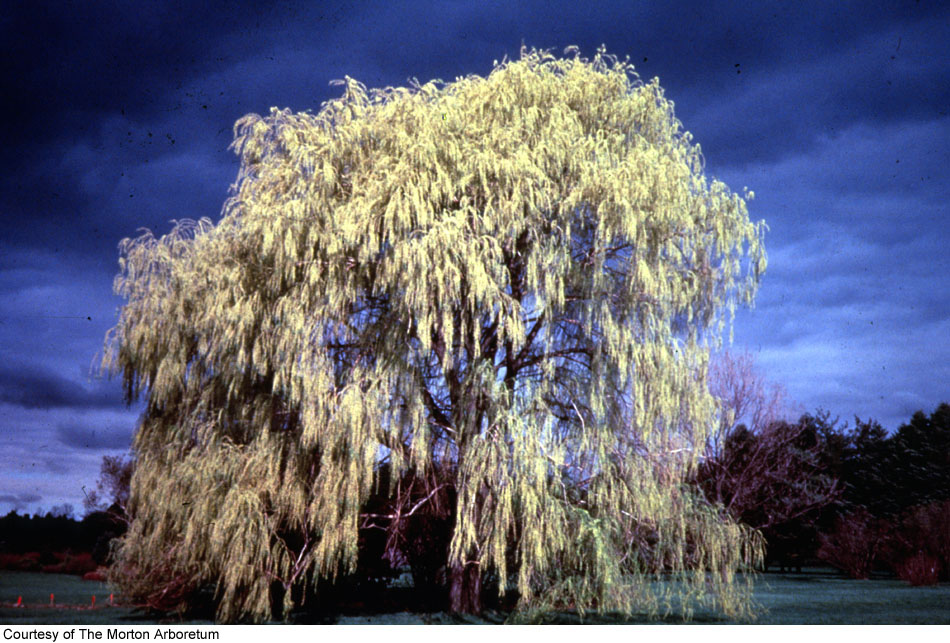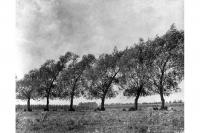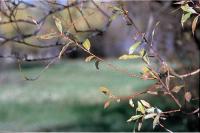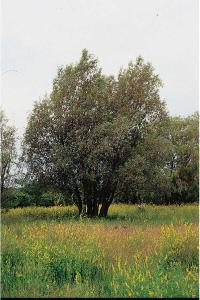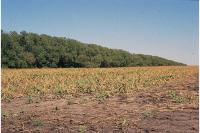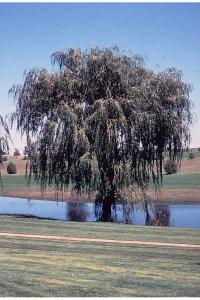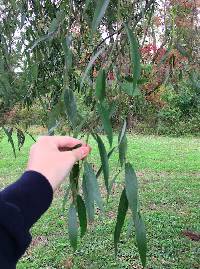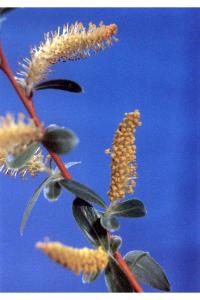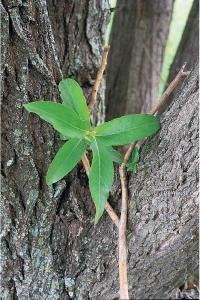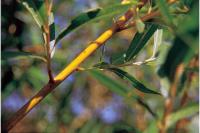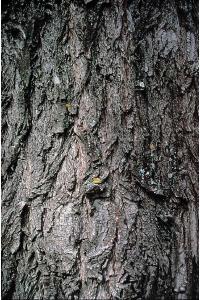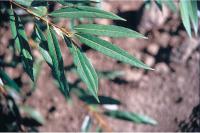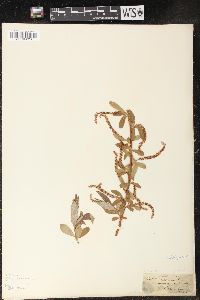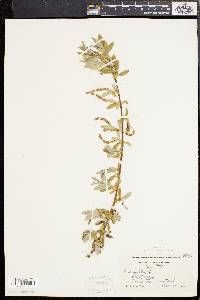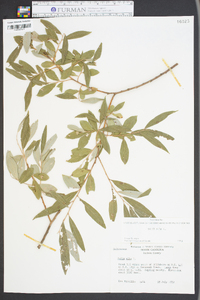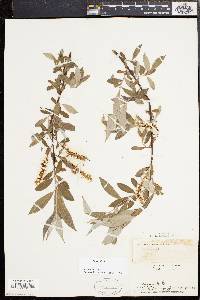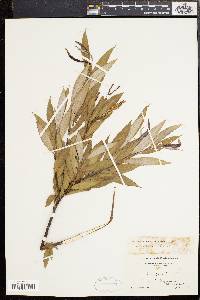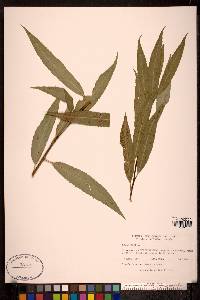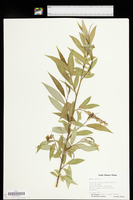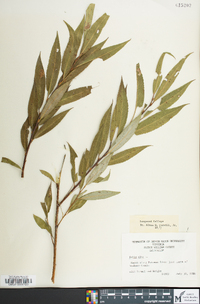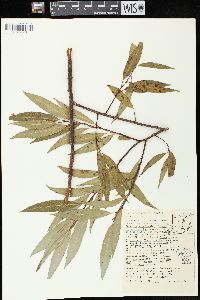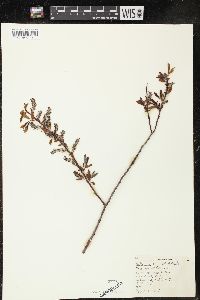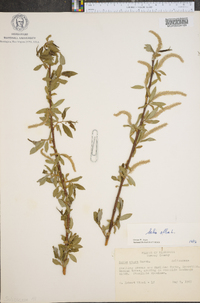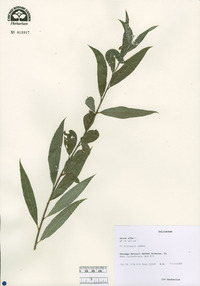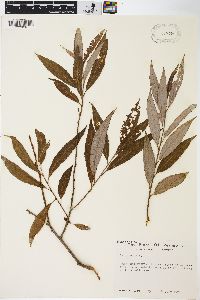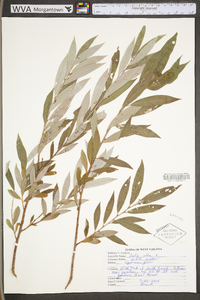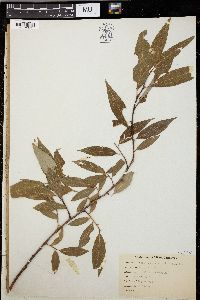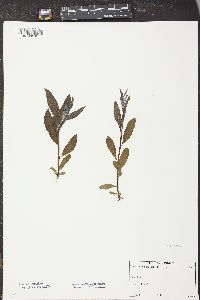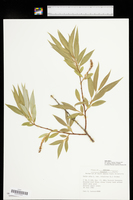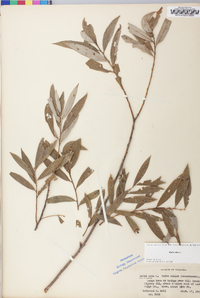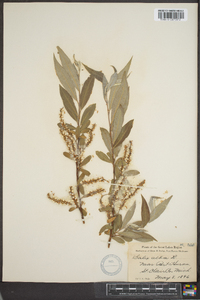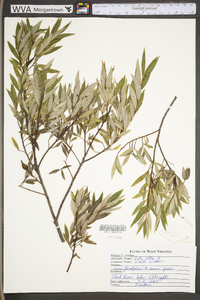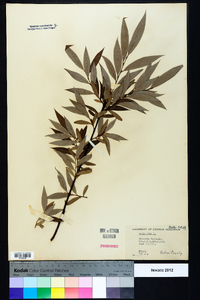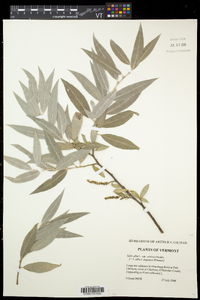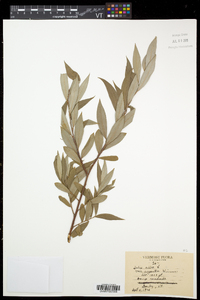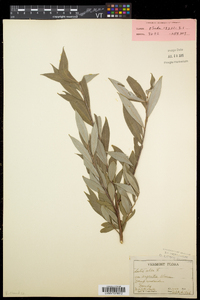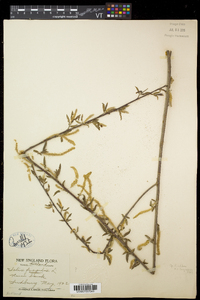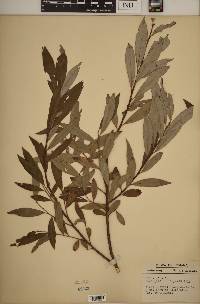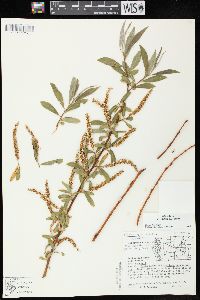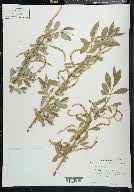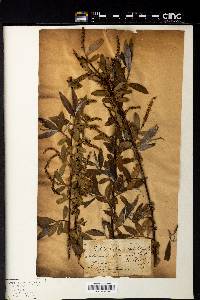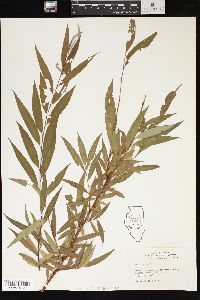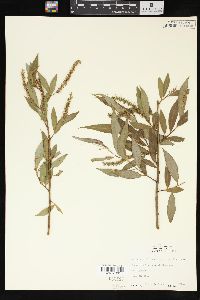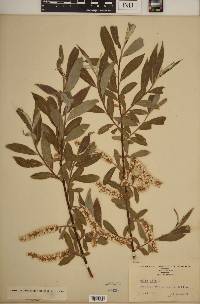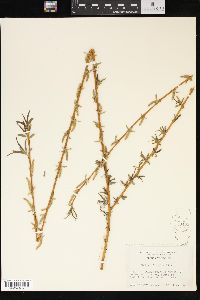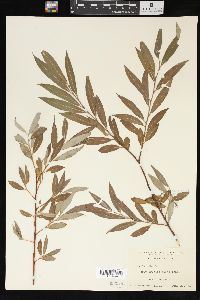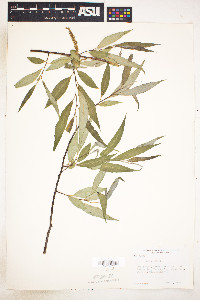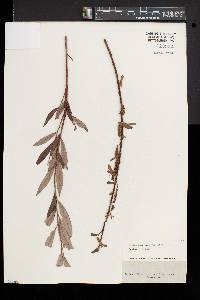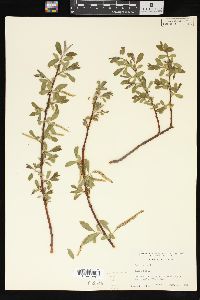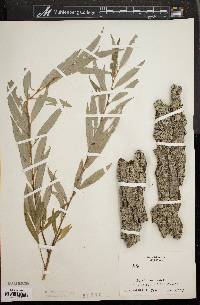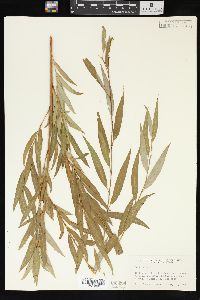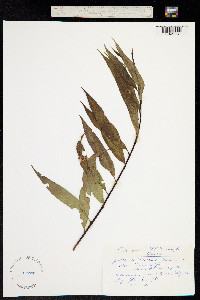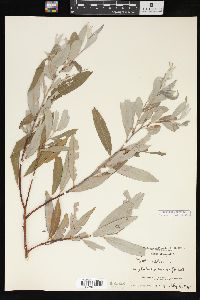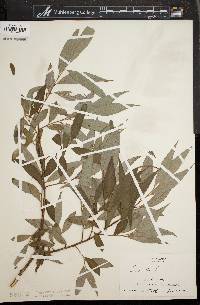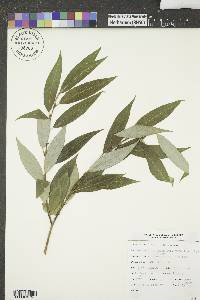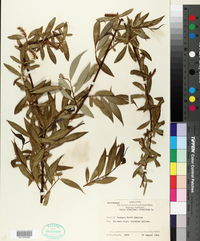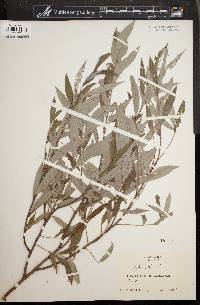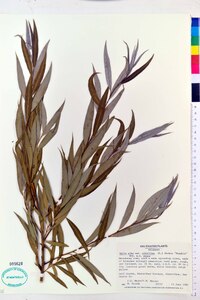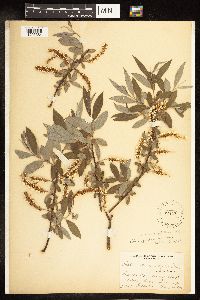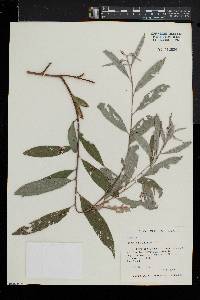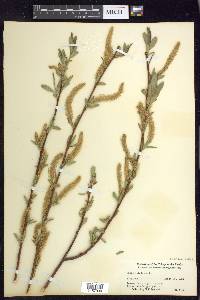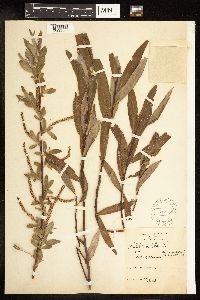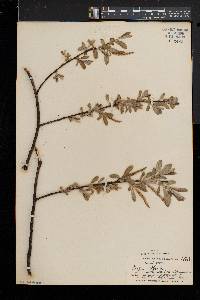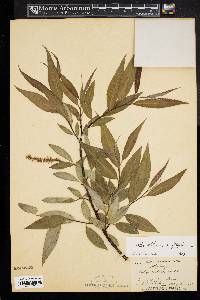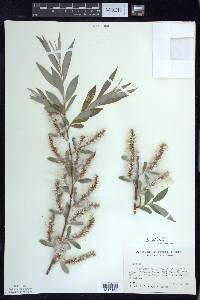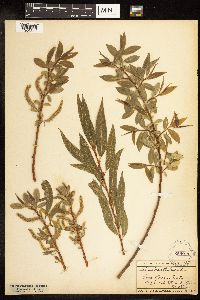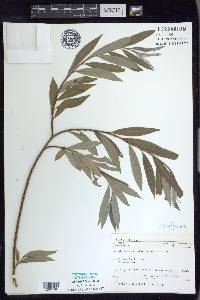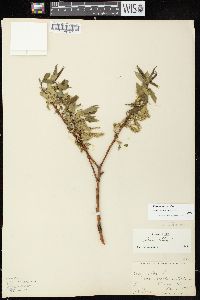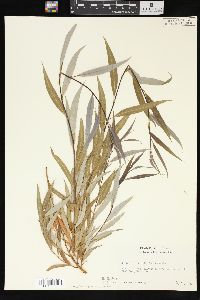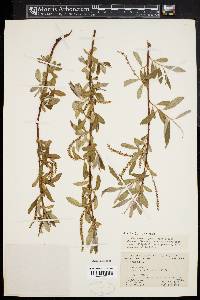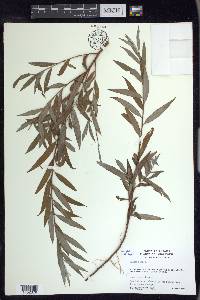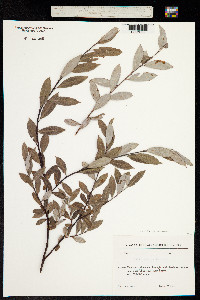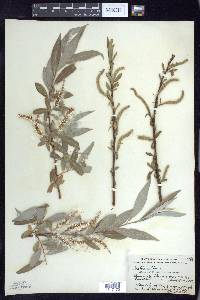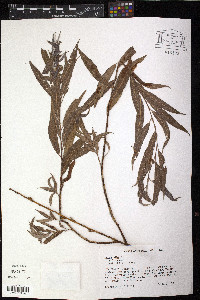
|
|
|
|
Family: Salicaceae
White Willow, more...golden willow
[Salix alba subsp. caerulea (Sm.) Rech. f., moreSalix alba subsp. vitellina (L.) Arcang., Salix alba var. caerulea (Sm.) Sm., Salix alba var. calva G.F.W. Mey., Salix alba var. vitellina (L.) Stokes, Salix pameachiana , Salix vitellina L., Salix x alba L. ?] |
Trees, 10-25 m. Stems: branches flexible or ± brittle at base, yellow, gray-brown, or red-brown, glabrous or hairy; branchlets yellowish or gray to red-brown, pilose, densely villous, or long-silky. Leaves: stipules rudimentary or absent on early ones, rudimentary or foliaceous on late ones, apex acute; petiole shallowly grooved adaxially, 3-13 mm, with pairs or clusters of spherical glands or lobes distally, long-silky abaxially; largest medial blade amphistomatous, narrowly oblong, very narrowly elliptic, narrowly elliptic, or lanceolate, 63-115 × 10-20 mm, 4.2-7.3 times as long as wide, base cuneate or convex, margins flat, serrate or serrulate, apex acuminate, caudate, or acute, abaxial surface very densely long-silky to glabrescent, hairs straight, (glaucous or obscured by hairs), adaxial dull, sparsely long-silky; proximal blade margins entire; juvenile blade yellowish green or reddish, very densely long-silky abaxially. Catkins: staminate 27-60 × 6-10 mm, flowering branchlet 2-8 mm; pistillate loosely flowered, slender, 31-51 × 4-8 mm, flowering branchlet 3-14 mm; floral bract 1.6-2.8 mm, apex rounded, entire, abaxially sparsely hairy, hairs straight. Staminate flowers: adaxial nectary oblong to square, 0.3-0.7 mm, nectaries usually distinct (rarely connate); filaments distinct, hairy on proximal 1/2 or basally; anthers (purple, turning yellow), shortly cylindrical to globose, 0.5-0.7 mm. Pistillate flowers: adaxial nectary square, 0.3-0.7 mm, equal to or shorter than stipe; stipe 0.2-0.8 mm; ovary obclavate to pyriform, beak slightly bulged below styles; ovules 8 or 9 per ovary; styles connate, 0.2-0.4 mm; stigmas flat, abaxially non-papillate with rounded tip, or broadly cylindrical, 0.3-0.6 mm. Capsules 3.5-5 mm. 2n = 76. Flowering early May-late Jun. Riverbanks, sandy beaches, fens, old fields, roadsides, gravel pits; 70-2000 m; introduced; N.B., Ont., Que., Sask.; Ariz., Ark., Calif., Colo., Conn., Del., D.C., Ga., Idaho, Ill., Ind., Ky., Maine, Md., Mass., Mich., Minn., Mo., Mont., Nebr., Nev., N.H., N.Y., N.C., Ohio, Pa., R.I., Tenn., Vt., Va., W.Va., Wis.; Eurasia. Reports that Salix alba is naturalized in Alberta, British Columbia, California, and Washington are undocumented. The variants of Salix alba, commonly cultivated in the flora area, are often treated as subspecies (K. H. Rechinger 1993) or varieties (R. D. Meikle 1984) but they are all cultivars. The most common ones are: S. alba cv. Sericea (S. alba var. sericea Gaudin) with densely and persistently long-silky leaves and branchlets; S. alba cv. Vitellina (S. alba var. vitellina (Linnaeus) Stokes) with yellow to yellow-brown branchlets and branches; S. alba cv. Caerulea (S. alba var. caerulea (Smith) Smith) with dark brown branchlets and leaves coarsely toothed and sparsely silky abaxially; and S. alba cv. Chermesina (S. alba var. chermesina Hartig) with reddish twigs. Plants referred to in the literature as S. alba var. vitellina cv. Pendula are treated here as S. ×sepulcralis. Hybrids: Salix alba forms natural hybrids with S. lucida and S. nigra. Hybrids with S. petiolaris have been reported (M. L. Fernald 1950) but no convincing specimens have been seen. Salix alba × S. nigra is an infrequent hybrid that is reported to have the catkins of S. alba and the foliage of S. nigra (M. S. Bebb 1895). Buds of this hybrid should be examined to see if they have the partially connate bud-scales characteristic of crosses between species with connate and distinct margins (J. Chmela 1978). Salix alba × S. euxina. See S. ×fragilis below. Salix alba × S. lucida. See S. ×jesupii [p. 43]. Salix alba var. vitellina × S. babylonica. See S. ×sepulcralis Simonkai [p. 40]. Salix ×fragilis Linnaeus: The hybrid white willow, S. alba Linnaeus × S. euxina I. Belyaeva, a European introduction, is the most commonly cultivated and naturalized tree-willow in the flora area. It is characterized by: trees, 3-20 m, stems erect or drooping; branches highly brittle at base; petioles with spherical or foliaceous glands distally, pilose or villous adaxially; largest medial leaf blade amphistomatous, very narrowly elliptic or narrowly elliptic, margins uniformly serrate or serrulate, abaxial surface glaucous, both surfaces sparsely long-silky to glabrescent, adaxial Plant: tree; to 25 m tall; stems branches flexible or brittle at base, gray- to red-brown, silky becoming glabrous; branchlets erect, drooping, or pendulous, yellowish, gray- to red-brown, silky, pilose, or villous Leaves: petioles 3-13 mm long, silky, gland-dotted at base of blade; young leaves silky; mature blade narrowly oblong or very narrowly elliptic to lanceolate, 63-115 mm long, 10-20 mm wide, 4.2-7.3 times as long as wide, the lower surface glaucous, very densely to sparsely silky becoming glabrous, the upper surface dull, silky becoming glabrous, the base acute to cuneate, the margins flat, serrate to serrulate, with 5-9 teeth per cm, the apex acute to acuminate INFLORESCENCE: coetaneous; floral bracts tawny, 1.6-2.8 mm long, glabrous or with straight hairs, the apices rounded; pistillate floral bracts deciduous after flowering Flowers: STAMINATE FLOWERS in moderately to densely flowered catkins 30-35 mm long; flowering branchlets 3-13 mm long; filaments hairy; nectaries 1 abaxial and 1 adaxial, broad, 0.3-0.7 mm long. PISTILLATE FLOWERS in loosely flowered catkins 35-60 mm long; flowering branchlets 10-25 mm long; ovaries glabrous; stigmas 0.32-0.56 mm long; styles 0.2-0.4 mm long; stipes 0.2-0.8 mm long; nectary square, 0.3-0.4 mm long, as long as or shorter than stipe Fruit: lanceolate or ovate Misc: Gardens or disturbed places, mostly near settlements; Apr-Jun REFERENCES: Argus, George W. 1995. SalicaceaePart 2. Salix. J. Ariz. - Nev. Acad. Sci. 29(1): 39 Medium-sized to large tree 15 - 25 m tall, trunk diameter 0.8 - 1.4 m Leaves: alternate, on 3 - 6 mm long, silky-hairy, glandular leafstalks, bright green above, whitish or silvery beneath, 4 - 10 cm long, 1 - 2.5 cm wide, lance-shaped with a tapering base and pointed tip, finely gland-toothed (six to ten per cm), firm, and silvery silky-hairy when young, remaining so beneath. In autumn the leaves turn yellow and drop late. Flowers: either male or female, borne on separate trees (dioecious) in slightly upright catkins. The catkin is greenish yellow, 3 - 6 cm long, cylindrical, slender, and it grows on a short, leafy stalk. Stamens two, anthers yellow. The ovary is conical. Fruit: a capsule, in an elongated cluster, nearly stalkless, green to light brown, 5 mm long, and flask-shaped. Seeds have long, white, silky hairs attached. Bark: brownish to dark gray, thick, and smooth on young trees, becoming rough and furrowed into thick ridges. Twigs: slender, golden brown to olive-brown, sometimes densely silky-hairy. Buds: appressed against the stem (except end bud), yellow to yellowish brown, 2 mm long, cylindrical, curved, downy, with a single bud scale. Terminal bud absent. Form: broad and rounded with upcurved main branches, spreading smaller branches, and drooping thinner shoots. Trunks one to four, often crooked. Similar species: In the Chicago Region, Salix alba differs from other tree willows by having finely toothed leaves that are white-hairy beneath and not revolute (rolled downward along the margins). Salix sericea, which has similar leaves, grows as a shrub. Flowering: late April to May, with the leaves Habitat and ecology: Introduced from Eurasia. Occasional along rivers, streams, lakes, and other wet sites, probably as an escape from cultivation. Occurence in the Chicago region: non-native Notes: Salix alba is planted as a shade and ornamental tree. It can be attacked by a number of disease and insect problems, such as cankers, rusts, aphids, and galls. Its leaves, twigs, and branches often drop, leaving much litter beneath the tree. Etymology: Salix is the Latin word for willow. Alba means white. Author: The Morton Arboretum Tree to 25 m; twigs spreading or sometimes pendulous, greenish to yellowish, long-sericeous, somewhat brittle at base; stipules minute and caducous; lvs narrowly lanceolate to lanceolate, 4-10(-15) נ1-2.5 cm, acuminate, with 7-10 glandular teeth per cm of margin, glaucous beneath, ±silvery-silky on both sides but especially beneath; petioles sericeous, 3-6 mm, those on vigorous young shoots glandular at the tip; catkins with the lvs, 3-6 cm, on peduncles 1-4 cm with 2-4 small lvs; scales as in no. 8 [Salix fragilis L.]; stamens mostly 2; fr ovoid-conic, 3-5 mm, glabrous, sessile or subsessile; style 0.2-0.4 mm; 2n=76. Native of Europe, sparingly escaped from cult. in our range. (S. a. var. vitellina, golden w., a long-established cultivar with bright yellow twigs) Hybridizes freely with nos. 8 and 9 [Salix babylonica L.] Gleason, Henry A. & Cronquist, Arthur J. 1991. Manual of vascular plants of northeastern United States and adjacent Canada. lxxv + 910 pp. ©The New York Botanical Garden. All rights reserved. Used by permission. From Flora of Indiana (1940) by Charles C. Deam White willow is a European species that, no doubt, has been planted more or less throughout the state. I have found it as an escape only a few times although it has been reported from 12 counties besides those in which I have found it. [Salix alba var. vitellina, known as golden willow, has subglabrous leaves and yellow rather than greenish branchlets.] This willow has been reported from 10 counties, mostly by our early authors who were not careful to distinguish between escaped and planted trees. I believe it is far more common than our white willow but I have seen it only a few times where I would consider it as an escape. I doubt that it ever escapes by seed but only by means of branchlets which have been broken off and carried down streams and deposited where they are covered with mud. …… Indiana Coefficient of Conservatism: C = null, non-native Wetland Indicator Status: OBL |

